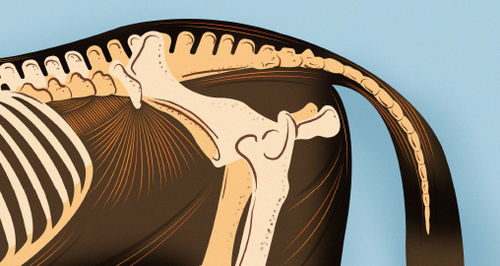
What is your horse's tail telling you?
Tail troubles can be a common cause of pain and discomfort in horses. To help you spot the tell-tail signs, Petplan Equine veterinary expert Gil Riley shares which symptoms to look out for and what you can do to help.
If your horse is… reluctant to move his tail or it pulls to one side
It could be a sign of: injury
'Your horse's tail is a continuation of his spine and, depending on his breed, can contain between 15 and 21 coccygeal vertebrae (although the average is 18),' Gil explains. 'As these bones lie within the fleshy part of the tail, they can be vulnerable to fractures due to falls, kicks from other horses or badly placed covering. A fractured tail may sit at a strange angle and can appear to be paralysed or, at the very least, your horse will be reluctant to move it.'
If an injury or fracture in the tail has resulted in nerve damage, it can cause a loss of muscle tension on one side of the hindquarters. This means your horse's tail may then be pulled to one side by the muscles that are still functioning normally. If you notice any of these signs, speak to your vet straight away.
If your horse is… trying to rub the underside of his tail against objects
It could be a sign of: pinworm
Pinworm (a parasite that looks similar to a bean sprout) can colonise your horse's rectum, where it feeds on mucus. The female worm emerges to lay her eggs outside the body, producing a slimy, sticky substance which you may notice around the anal area and down the hindquarters. This is highly irritating and causes your horse to scratch his rear end, often by hooking his tail over a fence to rub the underside.
'Pinworm is resistant to some modern worm medicines and, even those that contain effective drugs, often don't work as they're absorbed into the blood stream before they can reach the rectum where the worms live,' says Gil. He recommends using less advanced worming products, such as those containing the drug fenbendazole. 'These are absorbed from the gut less well, so a high level of active drug will reach the rectum,' he explains. 'You should also wash your horse's hindquarters every day with warm, soapy water and then dry them with a clean towel.'
If your horse is… clamping his tail to his hindquarters
It could be a sign of: a skin condition
Skin conditions most often cause wounds underneath the tail. 'When you have a lesion on the underside of the tail, a horse will respond by clamping his tail to his hindquarters. This prevents healing, as it limits the amount of blood to the area and there's also the added complication of this area becoming infected with faecal material,' Gil explains.
There are a number of skin conditions that affect the tail, including:
- Itching and skin irritation, which can lead to hair loss, skin infection and wounds that are difficult to heal. One possible cause is sweet itch (a condition caused by hypersensitivity to the saliva of the biting Culicoides midge). A horse with sweet itch will scratch the upper side of the dock, and sometimes his mane and belly. 'Once your horse is affected, it tends to get worse each year, so the only solution is to minimise exposure by keeping him indoors at dawn and dusk when the flies are most active, and to use a good quality fly rug from the very beginning of the season,' advises Gil.
- Melanoma, a type of skin growth that's most common in grey horses and often occurs underneath the tail. 'These growths are usually benign, so don't spread, but they can become very large and turn into ulcers,' Gil says. 'Give your horse regular check-ups and look out for any changes to the skin – a melanoma will appear as a shiny, black pea-sized swelling. If you spot one, book an appointment with your vet immediately. Melanomas are best treated while still small and can usually be removed by laser.'
- Irritation and infection caused by over-enthusiastic grooming. 'You should be careful not to over-pull your horse's tail as this can cause skin irritation and lead to infection,' says Gil. 'I've also seen tail bandaging that's applied too tightly cause ulcers on the underside of the tail. Leaving an excessively tight bandage on for even half an hour can severely affect the blood supply to the skin, which leads to ulcers forming. Nowadays, most people use tail guards, so it's not as much of a problem. But if you do decide to bandage, make sure you can slip a couple of fingers between the bandage and the tail.'
'One way to treat skin conditions around the tail is by using a donut bandage (a padded ring), which is positioned around the top of the tail,' Gil says. 'This will keep it elevated from the hindquarters, allowing any wounds or lesions underneath to heal.' As always, if you notice any differences in your horse's condition, don't hesitate to give your vet a call. They'll be able to advise you on the best treatments to keep him healthy – from top to tail.



